CD onboarding path
This topic describes the different phases and steps involved in onboarding with Harness CD. Follow these steps to ensure that you have all the settings and resources required for moving forward with your own deployments.
If you are only looking for tutorials, go to Continuous Delivery & GitOps tutorial.
Overview
This section lists the major onboarding phases and provides links to more details.
Steps with an asterisk "*" have YAML examples that can be used for setting up the step.
Phase 1: Initial setup
| Step | Details | Documentation Link | Demo Video |
|---|---|---|---|
| Account and entities setup | Create organization, project, invite initial users | Create organizations and projects | |
| Installing delegates | Kubernetes, Docker | Install Harness Delegate on Kubernetes or Docker | Watch Video |
| Installing secret managers, Migrating existing secrets | AWS KMS, HashiCorp, Azure Key Vault, Google KMS | Add a secret manager |
Phase 2: Deploy to QA
| Step | Details | Documentation Link | Demo Video |
|---|---|---|---|
| Service Definition and Variables * | Runtime Inputs or expressions | Create services | Watch Video |
| Environments * | Service Override | Create environments | Watch Video |
| Adding artifact sources | Docker Registry, GCR, GCS, ACR, Azure DevOps Artifacts, ECR, etc. | CD artifact sources | |
| Simple pipelines * | Stage, service, environment, infrastructure | CD pipeline modeling overview | Watch Video |
Phase 3: Deploy to staging
| Step | Details | Documentation Link | Demo Video |
|---|---|---|---|
| Deployment strategies * | Rollback, Blue Green, Canary, Kubernetes Apply, Kubernetes Scale | Deployment concepts and strategies | Watch Video |
| Triggers and input sets * | SCM triggers, artifact triggers | Pipeline triggers | Watch Video |
Phase 4: Deploy to production
| Step | Details | Documentation Link | Demo Video |
|---|---|---|---|
| Approvals and governance (OPA) * | Harness Approval, JIRA Approval | Approvals | Watch Video |
| RBAC | CoE, Distributed Center of DevOps | Role-based access control (RBAC) in Harness | Watch Video |
| Continuous Verification | Auto, Rolling Update, Canary, Blue Green, Load Test | Harness Continuous Verification (CV) overview |
Phase 5: SSO-enabled DevOps with Infrastructure as Code (IaC)
| Step | Details | Documentation Link | Demo Video |
|---|---|---|---|
| SSO | SAML SSO with Harness, Okta, OneLogin, Keycloak, etc | Single Sign-On (SSO) with SAML | |
| Templatization and automation * | Templates, Terraform Automation | Templates overview | Watch Video |
Phase 1: Initial setup
Step 1. Account and entities setup
Harness organizations (orgs) allow you to group projects that share the same goal. For example, all projects for a business unit or division.
A Harness project is a group of Harness modules and their pipelines. For example, a project might have a Harness CI pipeline to build code and push an image to a repo and a Harness CD pipeline to pull and deploy that image to a cloud platform.
Create a Harness org
- In Harness, in Account Settings, select Organizations.
- Select New Organization. The new organization settings appear.
- In Name, enter a name for your organization.
- Select Save and Continue.
Invite collaborators
- In Invite People to Collaborate, enter a user's name and select it.
- In Role, select the role the member will have in this org, such as Organization Admin or Organization Member.
- Select Add.
- Members receive invites via their email addresses.
- You can always invite more members from within the org later.
- Select Finish. The org is added to the list in Account Settings > Organizations.
Create a project
- In Harness, go to Home and select Projects.
- Select Project.
- Name the project, and select a color. The Id of the project is generated automatically.
- In Organization, select the org you created.
- Add a description and tags, and then select Save and Continue.
- In Invite Collaborators, type a member's name and select it.
- Select a role for the member, and select Add.
- Select Save and Continue to create the project.
Step 2. Installing Delegate
The Harness Delegate is a service you run in your local network or VPC to connect your artifacts, infrastructure, collaboration, verification, and other providers, with Harness Manager.
The first time you connect Harness to a third-party resource, the Harness Delegate is installed in your target infrastructure, for example, a Kubernetes cluster. After the delegate is installed and registers with Harness, you can Harness connect to third-party resources. The delegate performs all operations, including deployment and integration.
For more information, go to Install Harness Delegate on Kubernetes or Docker.
Step 3. Installing secret managers, migrating existing secrets
Harness includes a built-in secret management feature that enables you to store encrypted secrets, such as access keys, and use them in your Harness connectors and pipelines. For more information, go to Add a secret manager.
Looking for specific secret managers? Go to:
- Add an AWS KMS Secret Manager
- Add a HashiCorp Vault Secret Manager
- Add an Azure Key Vault Secret Manager
- Add Google KMS as a Harness Secret Manager
- Add an AWS Secrets Manager
Phase 2: Deploy to QA
Step 1. Service and environments
Services
Services represent your microservices and other workloads. Each service contains a Service Definition that defines your deployment artifacts, manifests or specifications, configuration files, and service-specific variables. For more information, go to Create a service.
Services are often configured using runtime inputs or expressions, so you can change service settings for different deployment scenarios at pipeline runtime. To use services with runtime inputs and expressions, go to Using services with inputs and expressions. Below are some example Kubernetes and ECS Fargate Harness services:
- K8s Service
- ECS Fargate Service
service:
name: k8s-svc
identifier: k8ssvc
serviceDefinition:
spec:
release:
name: release-<+INFRA_KEY_SHORT_ID>
manifests:
- manifest:
identifier: Kubernetes
type: K8sManifest
spec:
store:
type: Github
spec:
connectorRef: account.YourGitHubConnector
gitFetchType: Branch
paths:
- content/en/examples/application/nginx-app.yaml
repoName: kubernetes/website
branch: main
skipResourceVersioning: false
artifacts:
primary:
primaryArtifactRef: <+input>
sources:
- spec:
connectorRef: account.YourArtifactConnector
imagePath: bitnami/kafka
tag: <+input>
digest: ""
identifier: artifact
type: DockerRegistry
type: Kubernetes
tags: {}
service:
name: ecs-service
identifier: ecs_service
orgIdentifier: default
projectIdentifier: ECS Deployment
serviceDefinition:
type: ECS
spec:
manifests:
- manifest:
identifier: serviceDefinition
type: EcsServiceDefinition
spec:
store:
type: Github
spec:
connectorRef: org.YourGitHubConnector
gitFetchType: Branch
paths:
- applications/ecs-fargate-manifests/CreateServiceRequest.yaml
repoName: harness-community/developer-hub-apps
branch: main
- manifest:
identifier: taskDefinition
type: EcsTaskDefinition
spec:
store:
type: Github
spec:
connectorRef: org.YourGitHubConnector
gitFetchType: Branch
paths:
- ECS/BlueGreenNoVariables/RegisterTaskDefinitionRequest.yaml
repoName: harness-community/developer-hub-apps
branch: main
- manifest:
identifier: scalingPolicy
type: EcsScalingPolicyDefinition
spec:
store:
type: Github
spec:
connectorRef: org.GitHubConnector
gitFetchType: Branch
paths:
- applications/ecs-fargate-manifests/PutScalingPolicyRequest.yaml
repoName: harness-community/developer-hub-apps
branch: main
- manifest:
identifier: scalabletarget
type: EcsScalableTargetDefinition
spec:
store:
type: Github
spec:
connectorRef: org.GitHubConnector
gitFetchType: Branch
paths:
- applications/ecs-fargate-manifests/RegisterScalableTargetRequest.yaml
repoName: harness-community/developer-hub-apps
branch: main
artifacts:
primary:
primaryArtifactRef: <+input>
sources:
- spec:
connectorRef: org.YourAwsConnector
imagePath: your-image-path
tag: latest
region: us-east-1
identifier: ECRartifact
type: Ecr
gitOpsEnabled: false
Environments
Environments represent your deployment targets (QA, Prod, etc). Each environment contains one or more Infrastructure Definitions that list your target clusters, hosts, namespaces, etc. To create your own environments, go to Create environments.
- Environment Definition
- Infrastructure Definition
environment:
name: Env_1
identifier: Env_1
tags: {}
type: Production
orgIdentifier: default
projectIdentifier: Default_Project
variables: []
infrastructureDefinition:
name: Infra_1
identifier: Infra_1
orgIdentifier: default
projectIdentifier: Default_Project
environmentRef: Env_1
deploymentType: Kubernetes
type: KubernetesDirect
spec:
connectorRef: org.KubernetesConnectorForAutomationTest
namespace: cdp-k8s-qa-sanity
releaseName: release-<+INFRA_KEY_SHORT_ID>
allowSimultaneousDeployments: true
Service Overrides
In DevOps, it is common to have multiple environments, such as development, testing, staging, and production. Each environment might require different configurations or settings for the same service.
For example, in the development environment, a service may need to use a local database for testing, while in the production environment, it should use a high-availability database cluster.
To enable the same service to use different environment settings, DevOps teams can override service settings for each environment.
For more information, go to Create service overrides.
Step 2. Adding artifact sources
In DevOps, an artifact source is a location where the compiled, tested, and ready-to-deploy software artifacts are stored. These artifacts could be container images, compiled binary files, executables, or any other software components that are part of the application.
To add an artifact source, you add a Harness connector to the artifact platform (DockerHub, GCR, Artifactory, etc.) and then add an artifact source to a Harness service that defines the artifact source name, path, tags, and so on.
For the list of artifact sources that you can use in your Harness services, go to Artifact Sources.
Step 3. Create a simple pipeline
To create a simple CD pipeline, follow the steps:
- Create a pipeline.
- Add a CD stage.
- Define a service.
- Target an environment and infrastructure.
- Select execution steps.
- You can model visually, using YAML, or via the REST API.
Here's a simple CD pipeline using a Kubernetes type deployment:
K8s Rolling Deployment Pipeline YAML
pipeline:
name: K8s Rolling Deployment
identifier: K8s_Rolling_Deployment
projectIdentifier: Default Project
orgIdentifier: default
tags: {}
stages:
- stage:
name: Rolling Deployment
identifier: Rolling_Deployment
description: ""
type: Deployment
spec:
deploymentType: Kubernetes
service:
serviceRef: Service_1
serviceInputs:
serviceDefinition:
type: Kubernetes
spec:
artifacts:
primary:
primaryArtifactRef: <+input>
sources: <+input>
environment:
environmentRef: Env_1
deployToAll: false
infrastructureDefinitions:
- identifier: Infra_1
execution:
steps:
- step:
name: Rolling Deployment
identifier: rolloutDeployment
type: K8sRollingDeploy
timeout: 10m
spec:
skipDryRun: false
pruningEnabled: false
rollbackSteps:
- step:
name: Rollback Rollout Deployment
identifier: rollbackRolloutDeployment
type: K8sRollingRollback
timeout: 10m
spec:
pruningEnabled: false
tags: {}
failureStrategies:
- onFailure:
errors:
- AllErrors
action:
type: StageRollback
Phase 3: Deploy to Staging
Step 1. Deployment Strategy
You have likely heard terms like blue/green and canary when it comes to deploying code and applications into production. These are common deployment strategies, available in Harness CD as stage strategies, along with others.
The deployment strategies provided by Harness are:
- Rolling
- Blue Green
- Canary
- Basic Deployments
- Multi-service
- Rolling
- Blue Green
- Canary
- K8s with Apply
- K8s with Scale
pipeline:
name: K8s Rolling Deployment
identifier: K8s_Rolling_Deployment
projectIdentifier: Default Project
orgIdentifier: default
tags: {}
stages:
- stage:
name: Rolling Deployment
identifier: Rolling_Deployment
description: ""
type: Deployment
spec:
deploymentType: Kubernetes
service:
serviceRef: Service_1
serviceInputs:
serviceDefinition:
type: Kubernetes
spec:
artifacts:
primary:
primaryArtifactRef: <+input>
sources: <+input>
environment:
environmentRef: Env_1
deployToAll: false
infrastructureDefinitions:
- identifier: Infra_1
execution:
steps:
- step:
name: Rolling Deployment
identifier: rolloutDeployment
type: K8sRollingDeploy
timeout: 10m
spec:
skipDryRun: false
pruningEnabled: false
rollbackSteps:
- step:
name: Rollback Rollout Deployment
identifier: rollbackRolloutDeployment
type: K8sRollingRollback
timeout: 10m
spec:
pruningEnabled: false
tags: {}
failureStrategies:
- onFailure:
errors:
- AllErrors
action:
type: StageRollback
pipeline:
name: K8s Blue Green Deployment
identifier: K8s_Blue_Green_Deployment
projectIdentifier: Default Project
orgIdentifier: default
tags: {}
stages:
- stage:
name: Blue Green Deployment
identifier: Blue_Green_Deployment
description: ""
type: Deployment
spec:
deploymentType: Kubernetes
service:
serviceRef: Service_1
serviceInputs:
serviceDefinition:
type: Kubernetes
spec:
artifacts:
primary:
primaryArtifactRef: <+input>
sources: <+input>
environment:
environmentRef: Env_1
deployToAll: false
infrastructureDefinitions:
- identifier: Infra_1
execution:
steps:
- step:
name: Stage Deployment
identifier: stageDeployment
type: K8sBlueGreenDeploy
timeout: 10m
spec:
skipDryRun: false
pruningEnabled: false
- step:
name: Swap primary with stage service
identifier: bgSwapServices
type: K8sBGSwapServices
timeout: 10m
spec:
skipDryRun: false
rollbackSteps:
- step:
name: Swap primary with stage service
identifier: rollbackBgSwapServices
type: K8sBGSwapServices
timeout: 10m
spec:
skipDryRun: false
tags: {}
failureStrategies:
- onFailure:
errors:
- AllErrors
action:
type: StageRollback
timeout: 10m
variables:
- name: resourceNamePrefix
type: String
description: ""
required: false
value: cdpsanitysuites-trybg
pipeline:
name: K8s Canary Deployment
identifier: K8s_Canary_Deployment
projectIdentifier: Default Project
orgIdentifier: default
tags: {}
stages:
- stage:
name: Canary Deployment
identifier: Canary_Deployment
description: ""
type: Deployment
spec:
deploymentType: Kubernetes
service:
serviceRef: Service_1
serviceInputs:
serviceDefinition:
type: Kubernetes
spec:
artifacts:
primary:
primaryArtifactRef: <+input>
sources: <+input>
environment:
environmentRef: Env_1
deployToAll: false
infrastructureDefinitions:
- identifier: Infra_1
execution:
steps:
- stepGroup:
name: Canary Deployment
identifier: canaryDepoyment
steps:
- step:
name: Canary Deployment
identifier: canaryDeployment
type: K8sCanaryDeploy
timeout: 10m
spec:
instanceSelection:
type: Count
spec:
count: 1
skipDryRun: false
- step:
name: Canary Delete
identifier: canaryDelete
type: K8sCanaryDelete
timeout: 10m
spec: {}
- stepGroup:
name: Primary Deployment
identifier: primaryDepoyment
steps:
- step:
name: Rolling Deployment
identifier: rollingDeployment
type: K8sRollingDeploy
timeout: 10m
spec:
skipDryRun: false
rollbackSteps:
- step:
name: Canary Delete
identifier: rollbackCanaryDelete
type: K8sCanaryDelete
timeout: 10m
spec: {}
- step:
name: Rolling Rollback
identifier: rollingRollback
type: K8sRollingRollback
timeout: 10m
spec: {}
tags: {}
failureStrategies:
- onFailure:
errors:
- AllErrors
action:
type: StageRollback
variables:
- name: resourceNamePrefix
type: String
description: ""
required: false
value: cdpsanitysuites-trycanary
timeout: 10m
pipeline:
name: K8s Deployment with Apply Step
identifier: K8s_Deployment_with_Apply_Step
projectIdentifier: Default Project
orgIdentifier: default
tags: {}
stages:
- stage:
name: Deployment with Apply Step
identifier: Deployment_with_Apply_Step
description: ""
type: Deployment
spec:
deploymentType: Kubernetes
service:
serviceRef: Service_1
serviceInputs:
serviceDefinition:
type: Kubernetes
spec:
artifacts:
primary:
primaryArtifactRef: <+input>
sources: <+input>
environment:
environmentRef: Env_1
deployToAll: false
infrastructureDefinitions:
- identifier: Infra_1
execution:
steps:
- step:
type: K8sApply
name: K8s Apply
identifier: K8s_Apply
spec:
filePaths:
- namespace.yaml
- service.yaml
skipDryRun: false
skipSteadyStateCheck: false
skipRendering: false
overrides: []
timeout: 10m
rollbackSteps: []
tags: {}
failureStrategies:
- onFailure:
errors:
- AllErrors
action:
type: StageRollback
timeout: 10m
variables:
- name: resourceNamePrefix
type: String
description: ""
required: false
value: cdpsanitysuites-qwerandom
pipeline:
name: K8s Deployment with Scale Step
identifier: K8s_Deployment_with_Scale_Step
projectIdentifier: Default Project
orgIdentifier: default
tags: {}
stages:
- stage:
name: Deployment With Scale Step
identifier: Deployment_With_Scale_Step
description: ""
type: Deployment
spec:
deploymentType: Kubernetes
service:
serviceRef: Service_1
serviceInputs:
serviceDefinition:
type: Kubernetes
spec:
artifacts:
primary:
primaryArtifactRef: <+input>
sources: <+input>
environment:
environmentRef: Env_1
deployToAll: false
infrastructureDefinitions:
- identifier: Infra_1
execution:
steps:
- step:
name: Rollout Deployment
identifier: rolloutDeployment
type: K8sRollingDeploy
timeout: 10m
spec:
skipDryRun: false
pruningEnabled: false
- step:
type: K8sScale
name: K8sScale_1
identifier: K8sScale_1
spec:
workload: Deployment/<+stage.variables.resourceNamePrefix>-deployment
skipSteadyStateCheck: false
instanceSelection:
type: Count
spec:
count: 2
timeout: 10m
rollbackSteps:
- step:
name: Rollback Rollout Deployment
identifier: rollbackRolloutDeployment
type: K8sRollingRollback
timeout: 10m
spec:
pruningEnabled: false
tags: {}
failureStrategies:
- onFailure:
errors:
- AllErrors
action:
type: StageRollback
variables:
- name: resourceNamePrefix
type: String
description: ""
required: false
value: cdpsanitysuites-tryscale
timeout: 10m
For more information, go to Deployment concepts and strategies.
Step 2. Triggers and input sets
Triggers automatically initiate pipeline execution based on specific events or conditions, such as Git events, new Helm Charts, new artifacts, or specific time intervals. Triggers in Harness CD enable faster feedback cycles, enhanced efficiency, and decreased reliance on manual intervention during the deployment process.
Here are examples of a new artifact trigger and GitHub Webhook trigger:
- Trigger On New Artifact
- GitHub Webhook Trigger
trigger:
name: trigger_on_new_artifact_v2
identifier: trigger_on_new_artifact_v2
enabled: true
tags: {}
orgIdentifier: default
projectIdentifier: default_project
pipelineIdentifier: trigger_on_new_artifact
stagesToExecute: []
source:
type: Artifact
spec:
type: DockerRegistry
spec:
connectorRef: account.Pritish_Harness
imagePath: pritishharness/harness_test
tag: <+trigger.artifact.build>
eventConditions: []
inputYaml: |
pipeline:
identifier: trigger_on_new_artifact
stages:
- stage:
identifier: test
type: Deployment
spec:
service:
serviceInputs:
serviceDefinition:
type: Kubernetes
spec:
artifacts:
primary:
sources:
- identifier: artifact
type: DockerRegistry
spec:
tag: <+lastPublished.tag>
trigger:
name: github_filechange_trigger
identifier: github_filechange_trigger
enabled: true
encryptedWebhookSecretIdentifier: ""
description: ""
tags: {}
orgIdentifier: default
stagesToExecute: []
projectIdentifier: default_project
pipelineIdentifier: github_filechange_trigger
source:
type: Webhook
spec:
type: Github
spec:
type: PullRequest
spec:
connectorRef: account.CIPHERTron
autoAbortPreviousExecutions: false
payloadConditions:
- key: changedFiles
operator: Equals
value: README.md
- key: targetBranch
operator: Equals
value: main
headerConditions: []
repoName: harness-yarn-demo
actions:
- Open
inputYaml: |
pipeline:
identifier: github_filechange_trigger
properties:
ci:
codebase:
build:
type: branch
spec:
branch: <+trigger.branch>
Phase 4: Deploy to production
Step 1. Approvals and governance (OPA)
Approvals
- Harness manual approvals: You can specify Harness user group(s) to approve or reject a pipeline at any point in its execution. During deployment, the user group members use Harness Manager to approve or reject the pipeline deployment manually.
- JIRA approvals: Jira issues can be used to approve or reject a pipeline or stage at any point in its execution. During deployment, the pipeline evaluates the fields in the Jira ticket based on criteria you define. Its approval or rejection determines if the pipeline or stage may proceed. You can add the Jira Approval step in Approval stages or in CD stages. The Jira Approval step prevents the stage execution from proceeding without an approval.
- ServiceNow approvals: You can use ServiceNow tickets to approve or reject a pipeline or stage at any point in its execution. During deployment, a ServiceNow ticket's fields are evaluated according to the criteria you define, and its approval/rejection determines if the Pipeline or stage may proceed.
- Custom approvals: Custom approval stages and steps add control gates to your pipelines by allowing you to approve or reject a pipeline or stage at any point during build execution. When you add a Custom Approval step, you add a script to the step, and then use the script results as approval or rejection criteria.
To learn more about approvals, go to: Approvals.
Governance
Harness Policy As Code uses Open Policy Agent (OPA) as the central service to store and enforce policies for the different entities and processes across the Harness platform. You can centrally define and store policies and then select where (which entities) and when (which events) they will be applied.
Here are some Harness governance examples with OPA.
- Delegate Tag Governance
- Connectors Governance
- Environment Governance
package pipeline
# Allow pipeline execution only with specific delegate tag selected
deny[msg] {
# Find all pipeline stages
stage := input.pipeline.stages[_].stage
# Find all steps in each stage
step := stage.spec.execution.steps[_].step
# Check if the step has a delegate selector
delegateSelector := step.advanced.delegateSelector
# Check if the delegate selector has the specific tag
not contains(delegateSelector.tags, "specific_tag")
# Show a human-friendly error message
msg := sprintf("Pipeline '%s' cannot be executed without selecting a delegate with tag 'specific_tag'", [input.pipeline.name])
}
This policy denies pipeline execution if a step in any stage does not have the specific delegate tag selected in its delegate selector. If the tag is not selected, the policy will show a human-friendly error message.
package pipeline
# Deny pipeline execution if a specific connector is not selected
deny[msg] {
# Find all stages ...
stage = input.pipeline.stages[_].stage
# ... that have steps ...
step = stage.spec.execution.steps[_].step
# ... that use a connector ...
connector = step.spec.connectorRef.name
# ... that is not in the allowed list
not contains(allowed_connectors, connector)
# Show a human-friendly error message
msg := sprintf("Pipeline '%s' cannot use connector '%s'", [input.pipeline.name, connector])
}
# Connectors that can be used for pipeline execution
allowed_connectors = ["MyConnector1", "MyConnector2"]
contains(arr, elem) {
arr[_] = elem
}
You can customize the allowed_connectors list to include the connectors that are allowed for pipeline execution. If a pipeline uses a connector that is not in the allowed_connectors list, the policy will deny pipeline execution and display an error message.
package pipeline
# Deny pipelines that do not use allowed environments
# NOTE: Try removing "test" from the 'allowed_environments' list to see the policy fail
deny[msg] {
# Find all deployment stages
stage = input.pipeline.stages[_].stage
stage.type == "Deployment"
# ... where the environment is not in the allow list
not contains(allowed_environments, stage.spec.infrastructure.environment.identifier)
# Show a human-friendly error message
msg := sprintf("deployment stage '%s' cannot be deployed to environment '%s'", [stage.name, stage.spec.infrastructure.environment.identifier])
}
# Deny pipelines if the environment is missing completely
deny[msg] {
# Find all deployment stages
stage = input.pipeline.stages[_].stage
stage.type == "Deployment"
# ... without an environment
not stage.spec.infrastructure.environment.identifier
# Show a human-friendly error message
msg := sprintf("deployment stage '%s' has no environment identifier", [stage.name])
}
# Environments that can be used for deployment
allowed_environments = ["dev","qa","prod"]
contains(arr, elem) {
arr[_] = elem
}
You can modify the allowed_environments list to include the environments where you want the pipeline to be executed. If the pipeline is executed in an environment that is not in the allowed_environments list, the policy will fail and display an error message.
Freeze deployments
A deployment freeze is a period of time during which no new changes are made to a system or application. This ensures that a system or application remains stable and free of errors, particularly in the lead-up to a major event or release. During a deployment freeze, only critical bug fixes and security patches might be deployed, and all other changes are put on hold until the freeze is lifted. Deployment freezes are commonly used in software development to ensure that a system is not destabilized by the introduction of new code in new application versions.
For more information, go to Freeze deployments.
Here's a sample YAML to set up deployment freeze in Harness:
freeze:
name: test-freeze
identifier: testfreeze
entityConfigs:
- name: project_specific
entities:
- type: Project
filterType: NotEquals
entityRefs:
- chaosprjyps
- CI_QS_yps
- ypsnativehelm
- type: Service
filterType: All
- type: Environment
filterType: All
- type: EnvType
filterType: Equals
entityRefs:
- Production
status: Disabled
orgIdentifier: testOrgyps
windows:
- timeZone: Asia/Calcutta
startTime: 2023-11-18 08:39 PM
duration: 30m
recurrence:
type: Monthly
description: ""
Step 2. RBAC
To perform Role-based access control (RBAC), a Harness account administrator assigns resource-related permissions to members of Harness user groups. The Center of Excellence strategy and Distributed Center of DevOps strategy are the two most popular RBAC access control strategies used.
Center of excellence RBAC strategy
| Role Type | Role Description | Harness Roles | Harness Resource Groups |
|---|---|---|---|
| Program Manager | Responsible for analyzing and reporting various metrics | Shared Resources->Dashboards: View & Manage | Shared Resources -> Dashboards |
| Platform Admin | Responsible for provisioning infrastructure and managing Harness resources like Secrets, Environment, Connectors and Delegates | - Shared Resources -> Secrets: View, Create/Edit, Delete & Access - Shared Resources -> Connectors: View, Create/Edit, Delete & Access - Shared Resources -> Delegates: View, Create/Edit & Delete - Shared Resources -> Delegate Configurations: View, Create/Edit & Delete - Environments: View, Create/Edit, Delete & Access - Environment Groups: View, Create/Edit, Delete & Access | - Shared Resources -> Secrets - Shared Resources -> Connectors - Shared Resources -> Delegates - Shared Resources -> Delegate Configurations - Environments - Environment Groups |
| Devops Admin | Responsible for setting up Policies to adhere to certain organizational standards, managing Users and various other things like Default Settings, Auth Settings, etc | Administrative Functions: All permissions Services: View, Create/Edit, Delete & Access Environments: View & Access Environment Groups: View & Access Shared Resources -> Templates: View, Create/Edit, Delete, Access & Copy Shared Resources -> Files: View, Create/Edit, Delete & Access Shared Resources -> Deployment Freeze: Manage, Override & Global Shared Resources -> Secrets: View & Access Shared Resources -> Connectors: View & Access Shared Resources -> Variables: View, Create/Edit & Delete Shared Resources -> Delegates: View Shared Resources -> Delegate Configurations: View Pipelines: View, Create/Edit, Delete & Execute | Administrative Functions: All Resources under it Shared Resources: All Resources under it except Dashboards Services Environments Environment Groups Pipelines |
| Devops Engineer | Responsible for managing Services, Templates, Files, Variables, Pipelines, Triggers, Input Sets etc. | Services: View, Create/Edit & Access Environments: View & Access Environment Groups: View & Access Shared Resources -> Templates: View, Create/Edit, Access & Copy Shared Resources -> Secrets: View & Access Shared Resources -> Connectors: View & Access Shared Resources -> Variables: View & Create/Edit Shared Resources -> Files: View & Create/Edit Pipelines: View, Create/Edit & Execute | Shared Resources: All Resources under it except Dashboards Services Environments Environment Groups Pipelines |
Distributed DevOps strategy
| Role Type | Role Description | Harness Roles | Harness Resource Groups | Resource Scope |
|---|---|---|---|---|
| Harness Admin | Responsible for managing Users and various other things like Default Settings, Auth Settings, etc | Administrative Functions: All permissions | Administrative Functions: All Resources under it | All (including all Organizations and Projects) |
| Project DevOps Admin | Responsible for provisioning infrastructure and managing Harness resources like Secrets, Environment, Connectors and Delegates, setting up Policies to adhere to certain organizational standards and keeping an eye on all the entities of an Organization within Harness Platform | Services: View, Create/Edit, Delete & Access Shared Resources -> Templates: View, Create/Edit, Delete, Access & Copy Shared Resources -> Files: View, Create/Edit, Delete & Access Shared Resources -> Deployment Freeze: Manage, Override & Global Shared Resources -> Secrets: View, Create/Edit, Delete & Access Shared Resources -> Connectors: View, Create/Edit, Delete & Access Shared Resources -> Delegates: View, Create/Edit & Delete Shared Resources -> Delegate Configurations: View, Create/Edit & Delete Environments: View, Create/Edit, Delete & Access Environment Groups: View, Create/Edit, Delete & Access Shared Resources -> Variables: View, Create/Edit & Delete Pipelines: View, Create/Edit, Delete & Execute Shared Resources -> Dashboards: View & Manage | Shared Resources Services Environments Environment Groups Pipelines | Specified Organizations (and their Projects) |
| Project DevOps Engineer | Responsible for managing Services, Templates, Files, Variables, Pipelines, Triggers, Input Sets etc. of an Organization within Harness Platform | Services: View, Create/Edit & Access Shared Resources -> Templates: View, Create/Edit, Access & Copy Shared Resources -> Secrets: View & Access Shared Resources -> Connectors: View & Access Shared Resources -> Variables: View & Create/Edit Shared Resources -> Files: View & Create/Edit Environments: View & Access Environment Groups: View & Access Pipelines: View, Create/Edit & Execute Shared Resources -> Dashboards: View | Shared Resources Services Environments Environment Groups Pipelines | Specified Organizations (and their Projects) |
- Center of Excellence
- Distruibuted DevOps
- Program Manager
- Platform Admin
- DevOps Admin
- DevOps Engineer
Roles
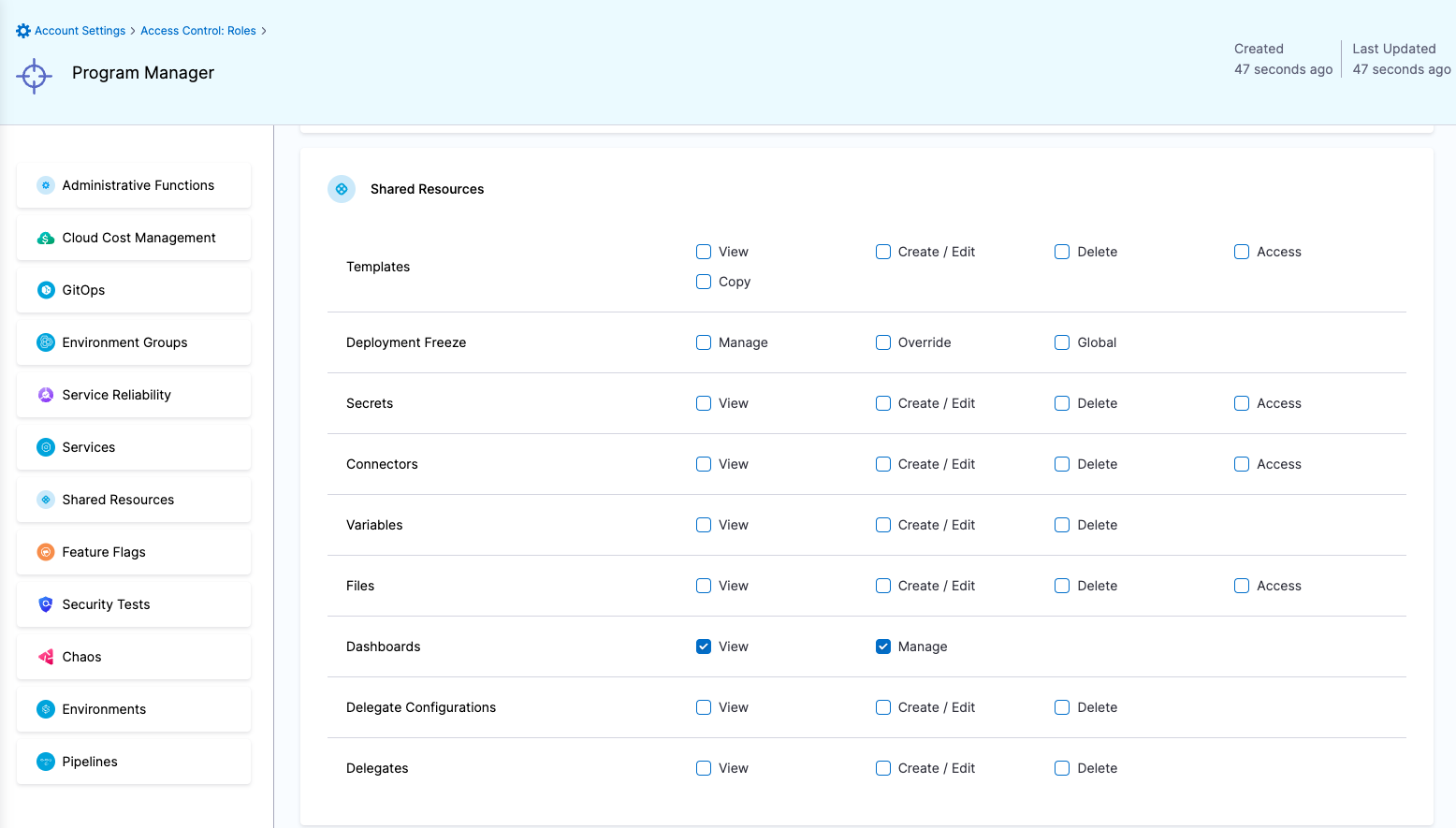
Resource Groups

Roles
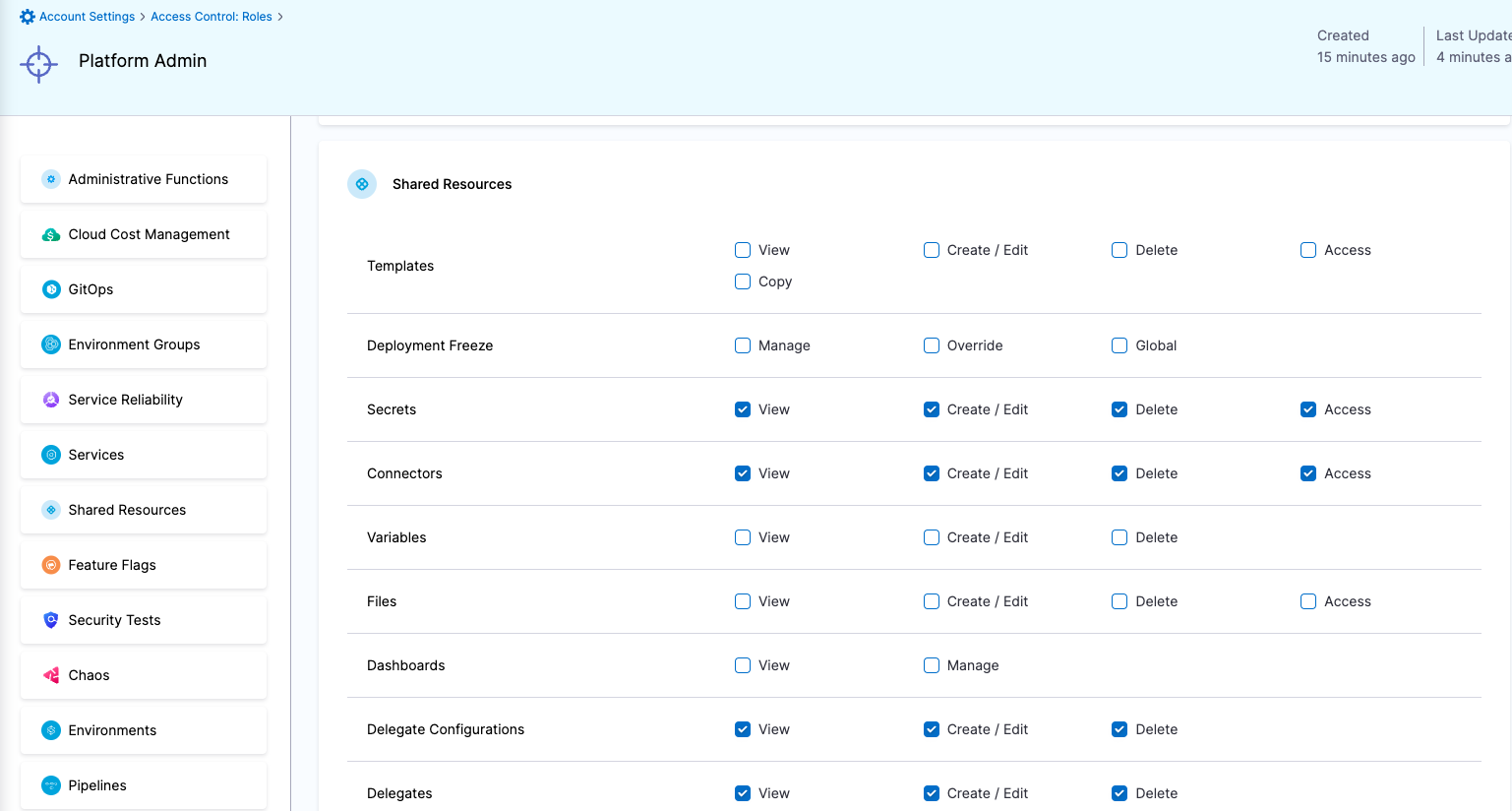


Resource Groups
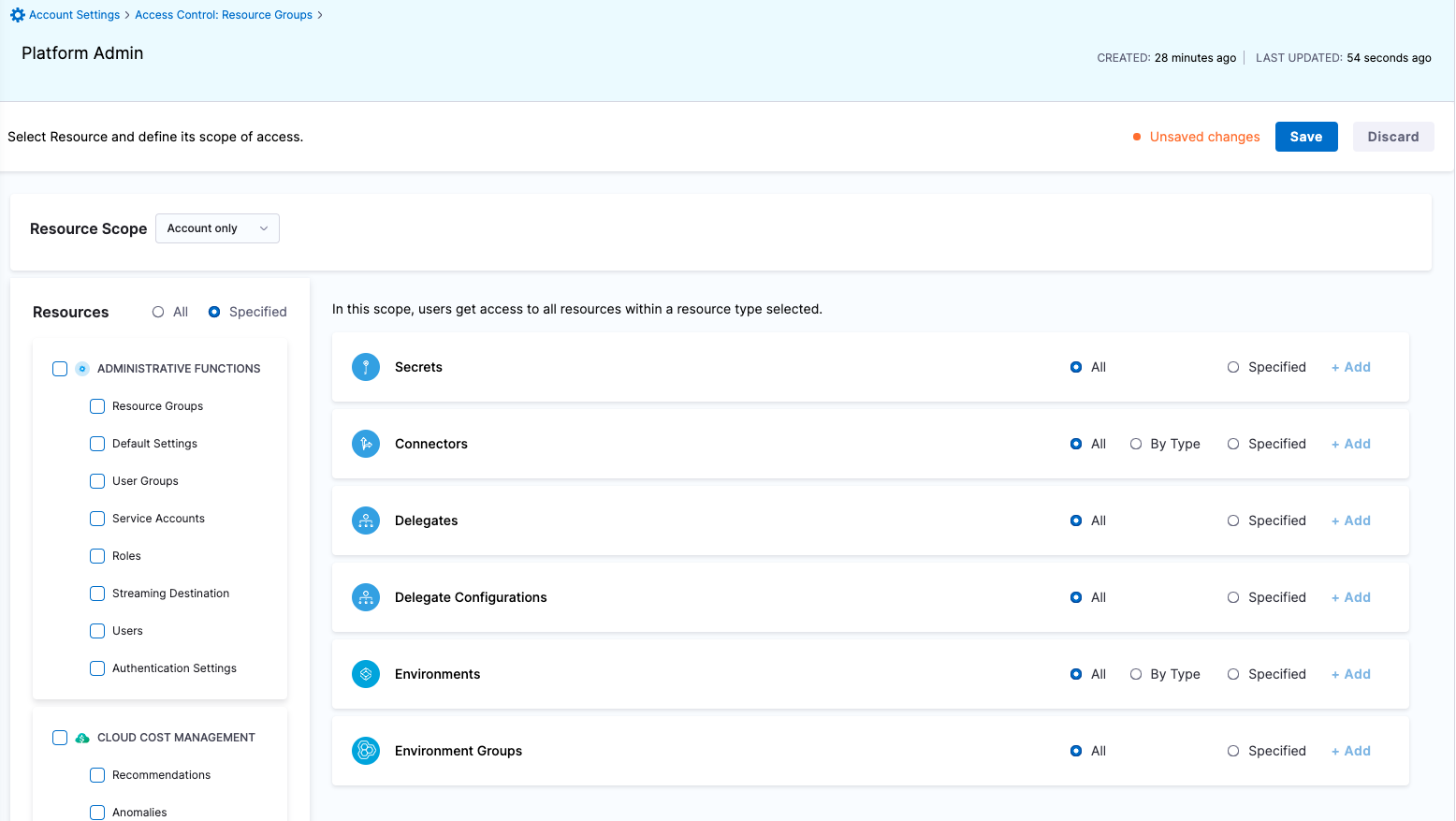
Roles
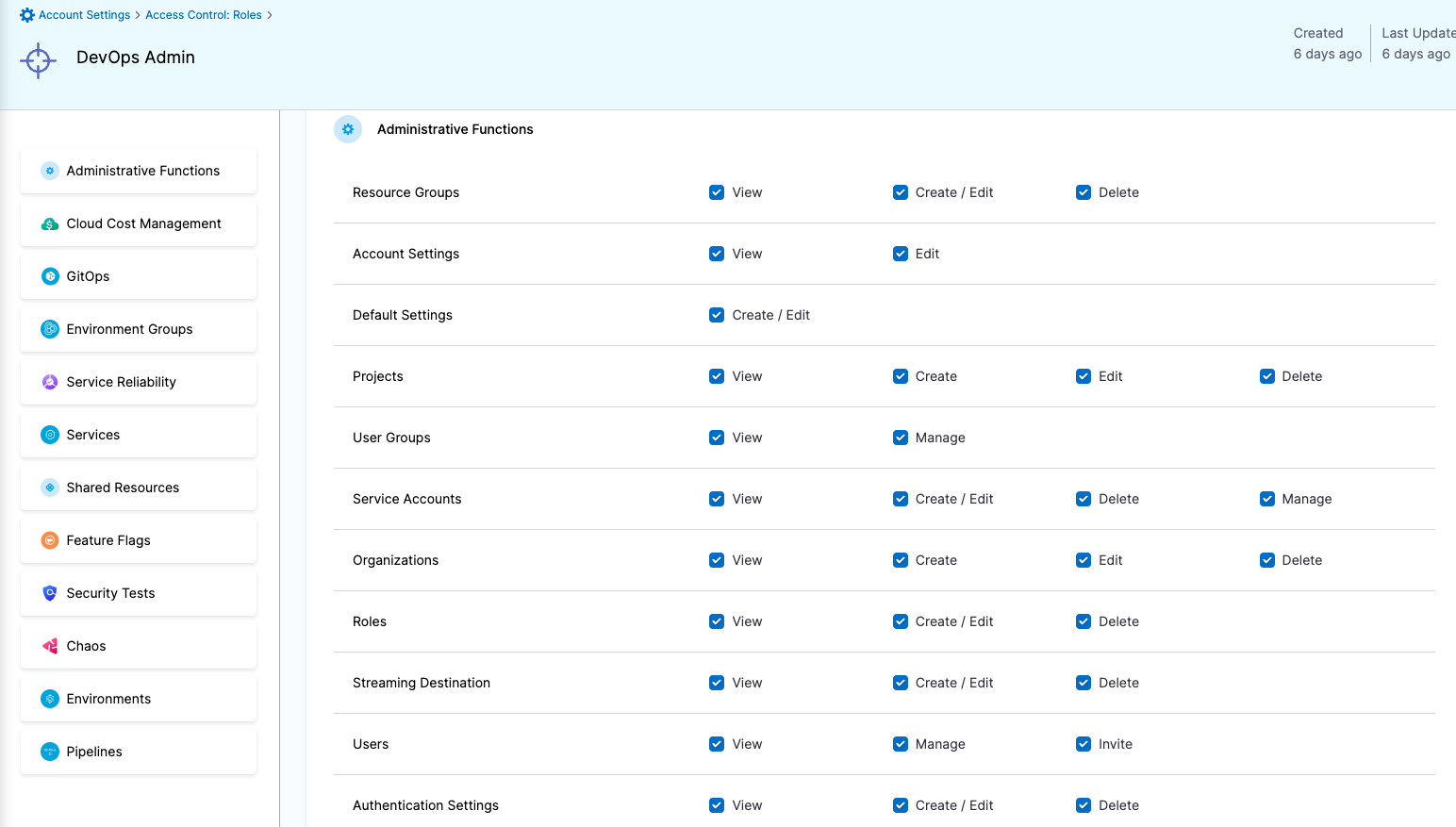
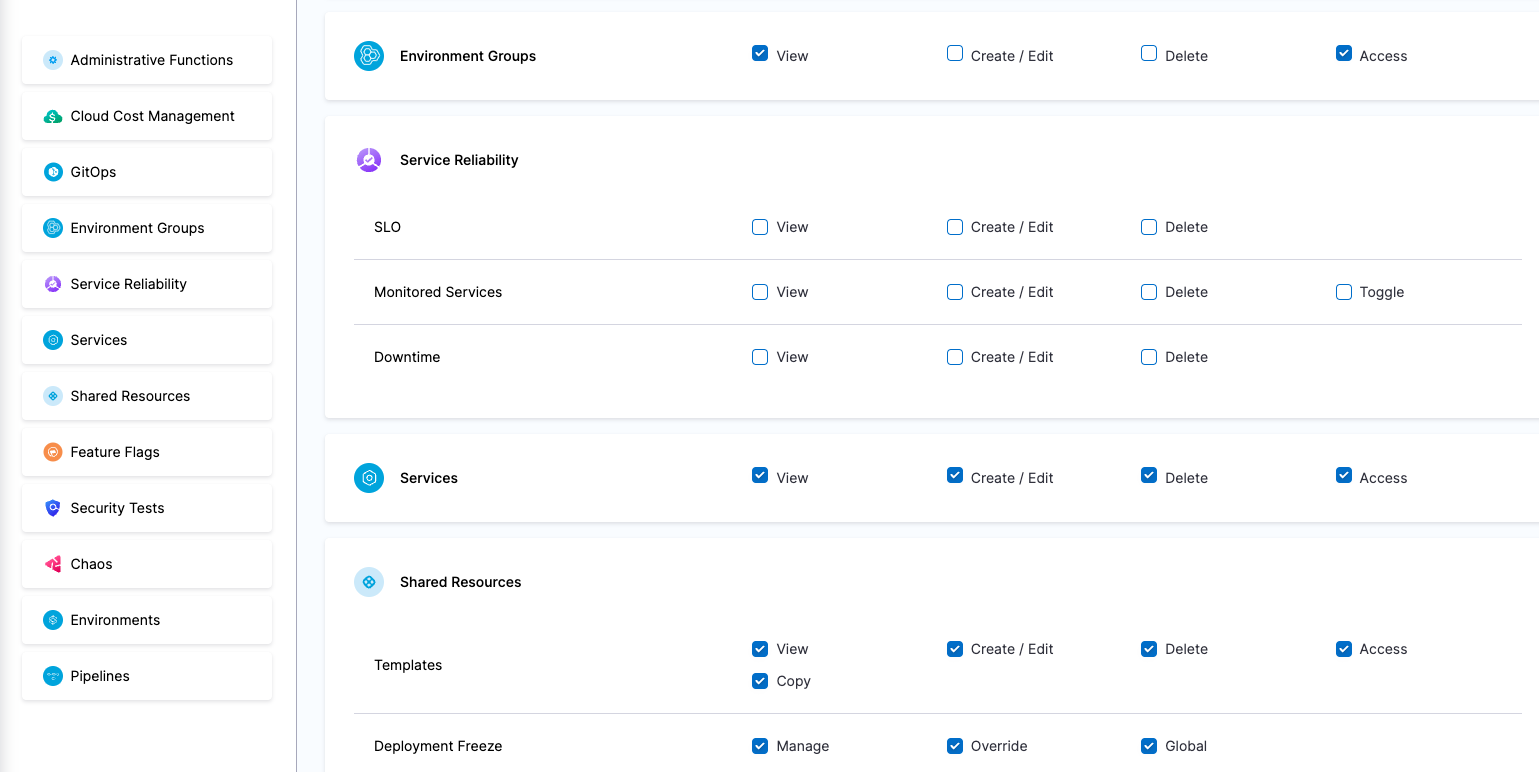


Resource Groups
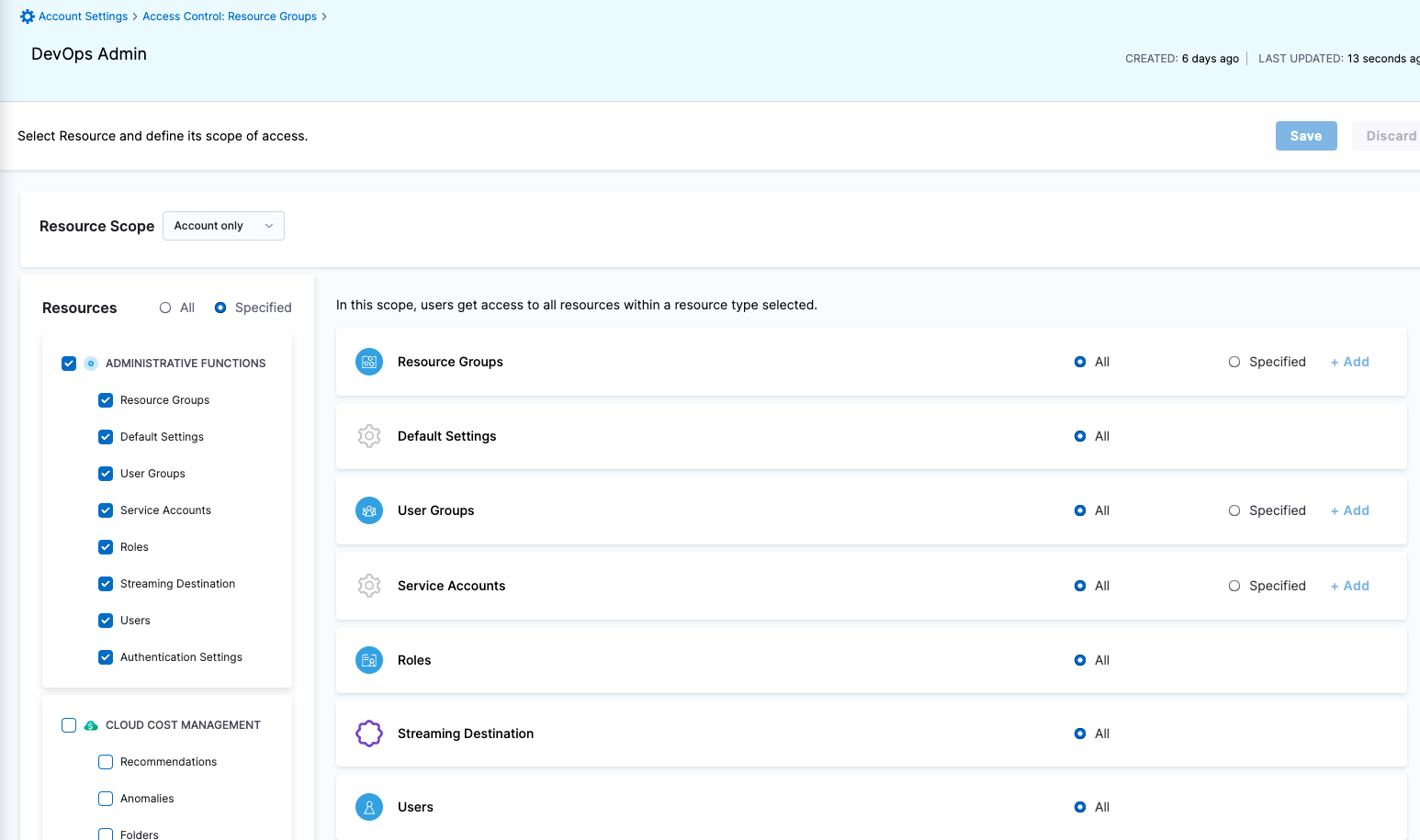

Roles



Resource Groups
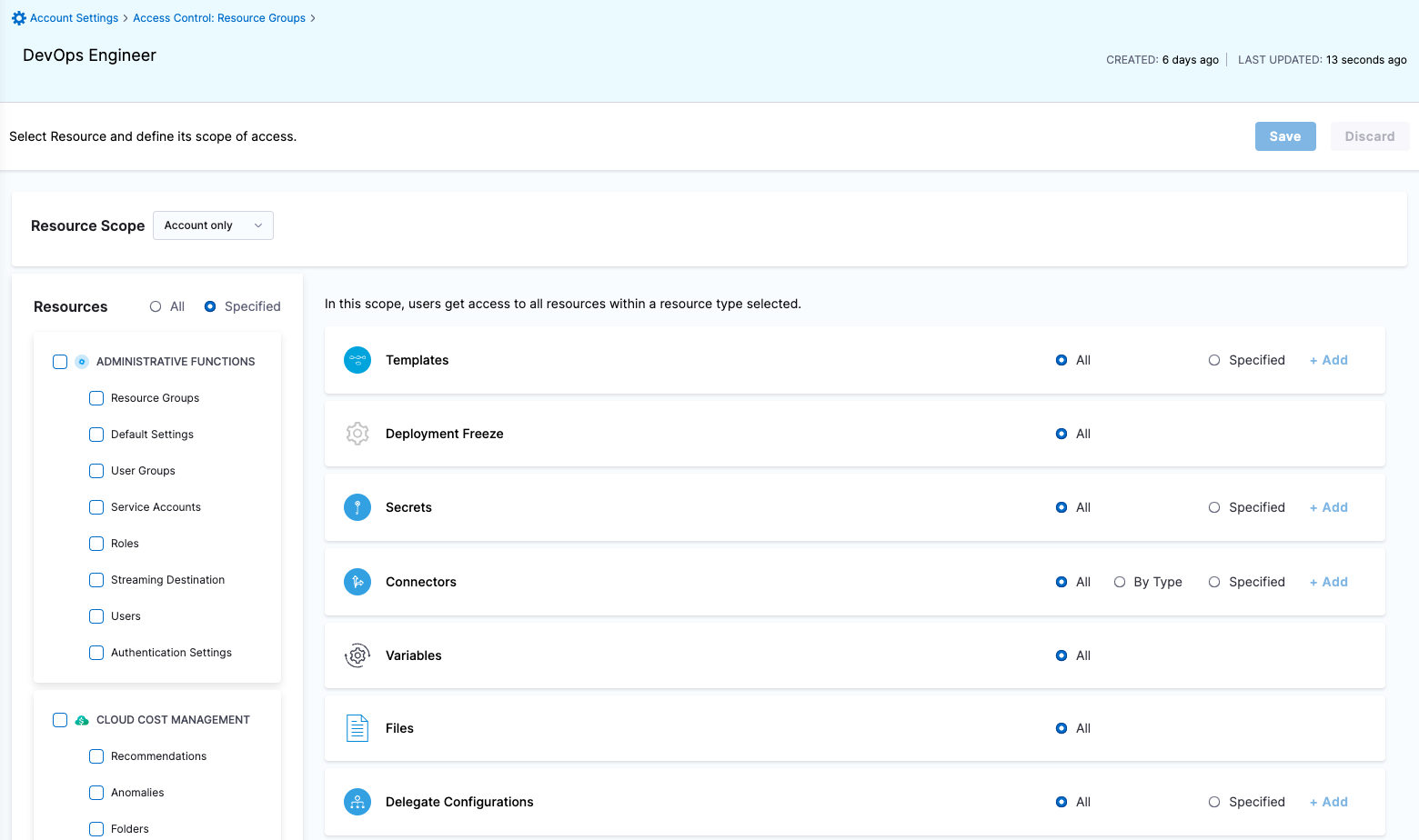

- Harness Admin
- Project DevOps Admin
- Project DevOps Engineer
Roles
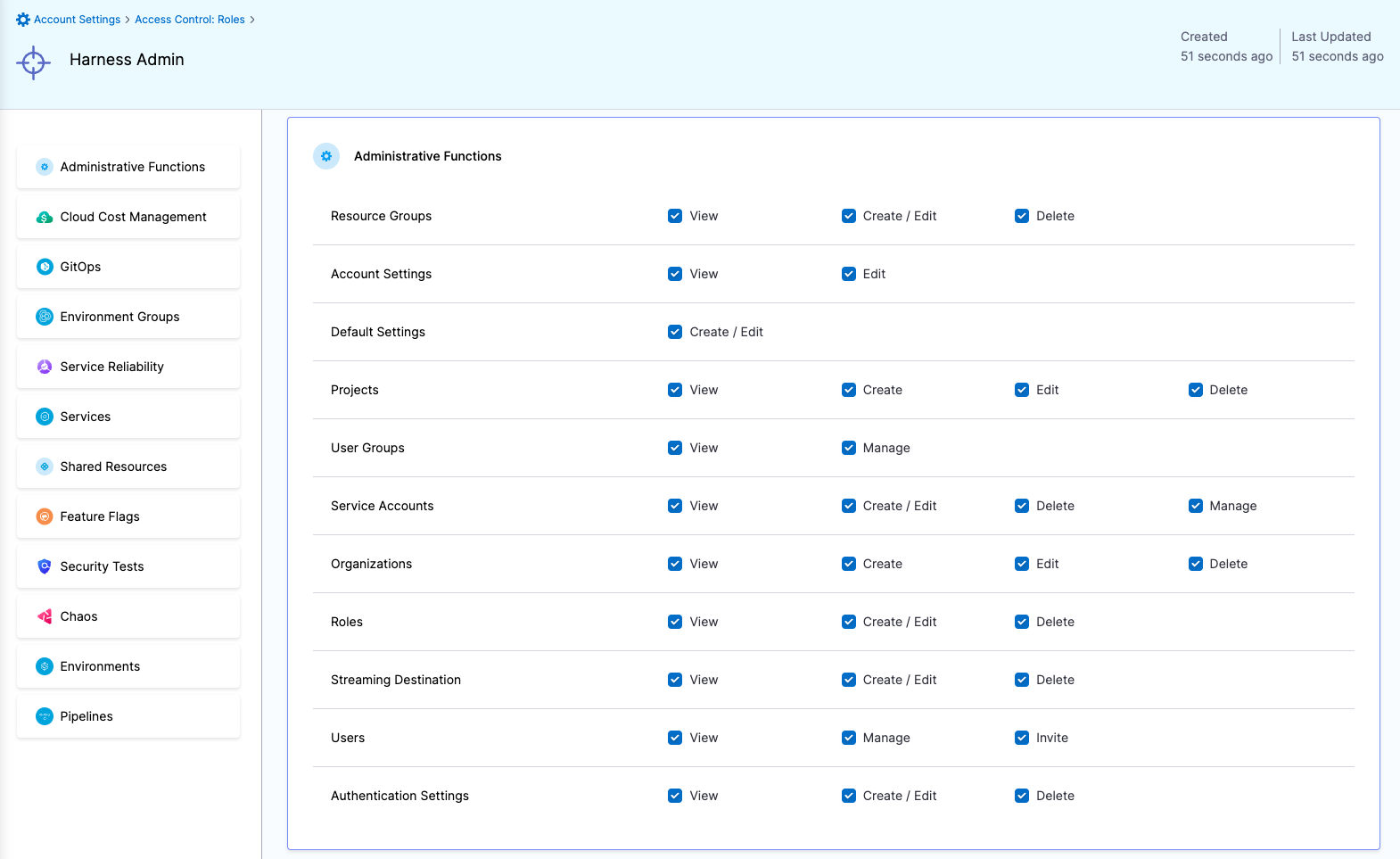
Resource Groups

Roles
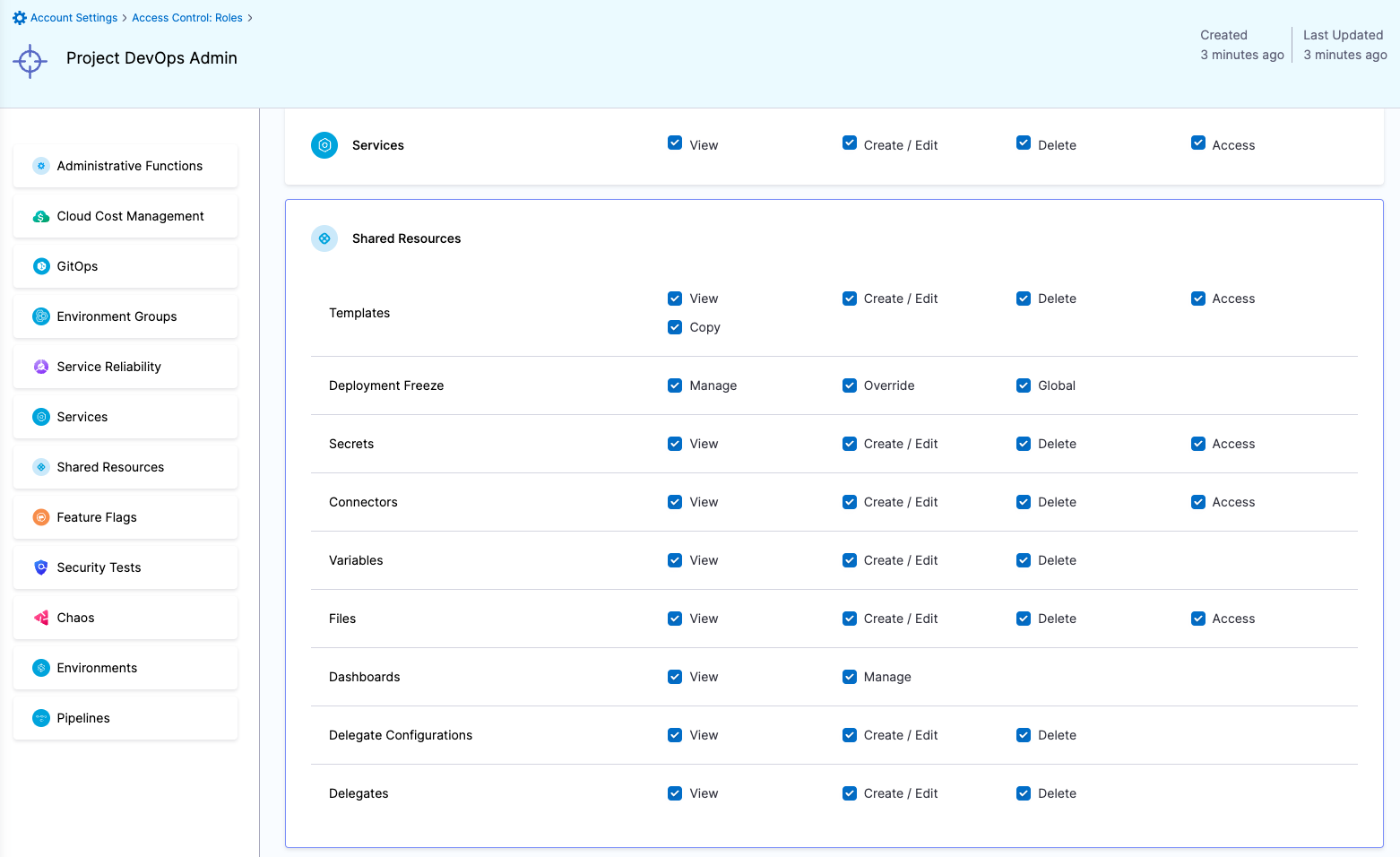

Resource Groups
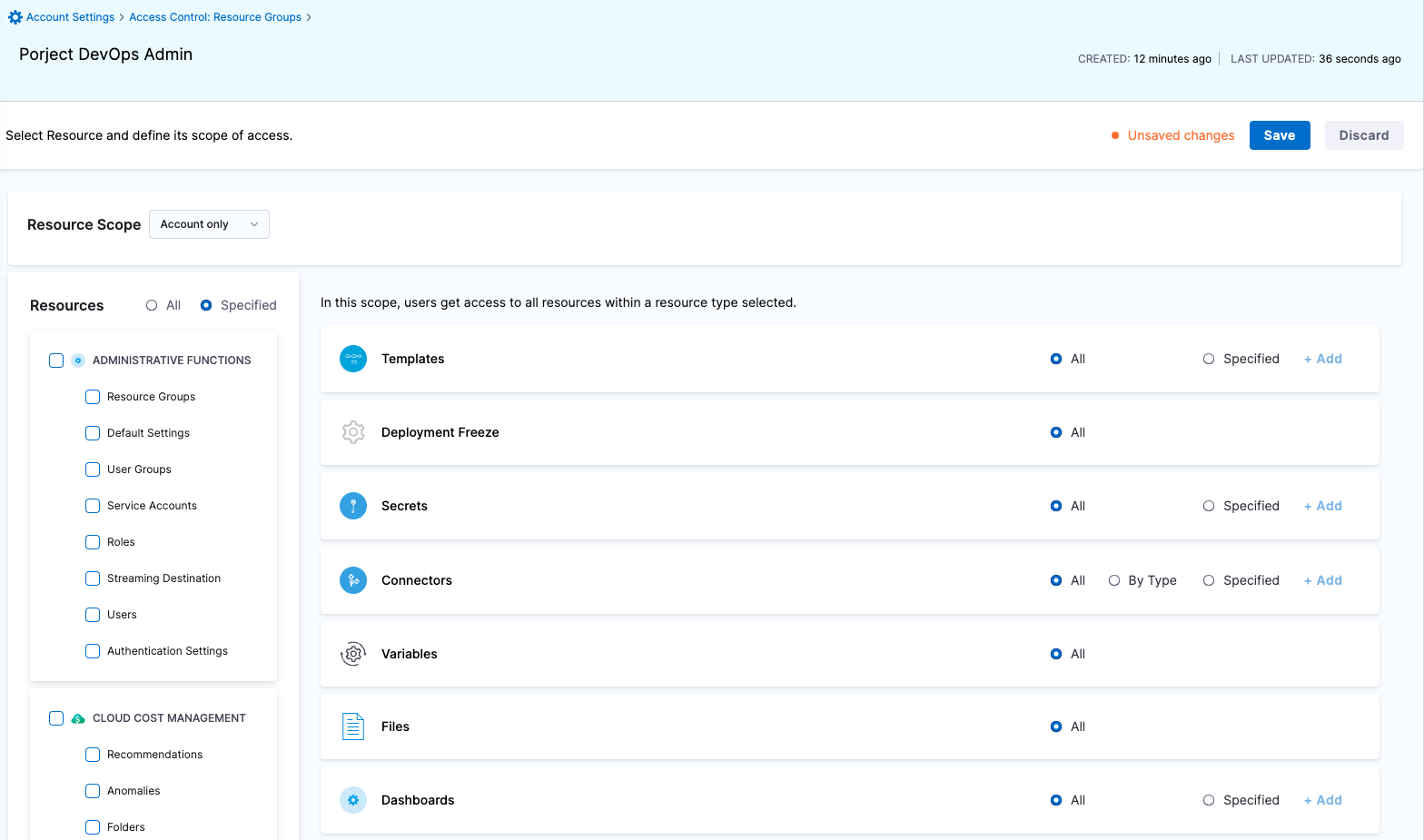
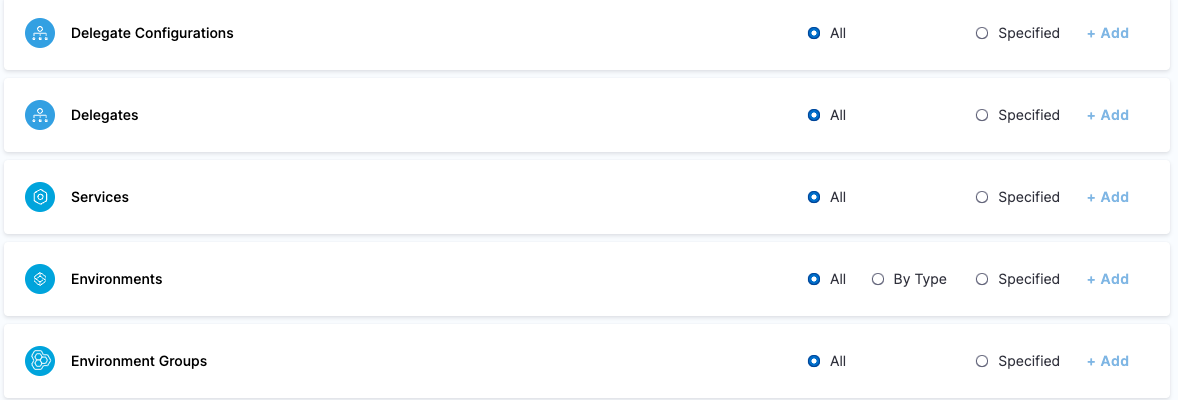
Roles



Resource Groups


For more information, go to
Take a look at Role-based access control (RBAC) in Harness article to configure RBAC in Harness
Step 3. Continuous Verification
Harness Continuous Verification (CV) is a critical tool in the deployment pipeline that validates deployments by integrating with APMs and logging tools to verify that the deployment is running safely and efficiently.
Harness CV applies machine learning algorithms to every deployment for identifying normal behavior. This allows Harness to identify and flag anomalies in future deployments. During the Verify step, Harness CV automatically triggers a rollback if anomalies are found.
Deployment strategies for Continuous Verification:
- Continuous Verification type
- Auto
- Rolling Update
- Canary
- Blue Green
- Load Test
- Sensitivity
- Duration
- Artifact tag
- Fail on no analysis
- Health Source
For more information, go to Configure CV.
Phase 5: SSO-enabled DevOps with Infrastructure as Code (IaC)
Step 1. SSO
Harness supports Single Sign-On (SSO) with SAML, integrating with your SAML SSO provider to enable you to log your users into Harness as part of your SSO infrastructure. The user can choose between a variety of SSO integrations according to their needs.
For more information, go to Authentication.
Step 2. Templatization & Automation
Templatization
Harness enables you to add templates to create reusable logic and Harness entities (like steps, stages, and pipelines) in your pipelines. You can link templates in your pipelines or share them with your teams for improved efficiency.
Templates enhance developer productivity, reduce onboarding time, and enforce standardization across the teams that use Harness. Here's an example template that builds a JavaScript application, runs unit tests and pushes to docker registry.
Sample Golden Deployment Pipeline Template
template:
name: Golden Deploy
identifier: Golden_Deploy
type: Stage
projectIdentifier: Platform_Demo
orgIdentifier: default
spec:
type: Deployment
spec:
serviceConfig:
serviceDefinition:
type: Kubernetes
spec:
artifacts:
sidecars: []
primary:
type: Gcr
spec:
connectorRef: TestGCP_inherit
imagePath: sales-209522/platform-demo
registryHostname: us.gcr.io
tag: <+pipeline.sequenceId>
manifestOverrideSets: []
manifests:
- manifest:
identifier: HarnessAppDemoManifests
type: K8sManifest
spec:
store:
type: Github
spec:
connectorRef: Platformdemo2
gitFetchType: Branch
paths:
- k8s/manifests/namespace.yml
- k8s/manifests/volumeclaim-creation.yml
- k8s/manifests/nodeport-deployment.yml
- k8s/manifests/ingress-deployment.yml
- k8s/manifests/app-deployment.yml
branch: main
skipResourceVersioning: false
- manifest:
identifier: values
type: Values
spec:
store:
type: Github
spec:
connectorRef: Platformdemo2
gitFetchType: Branch
paths:
- k8s/values/values.yml
branch: main
serviceRef: HarnessPlatformDemoApp
infrastructure:
environmentRef: k8sProduction
infrastructureDefinition:
type: KubernetesDirect
spec:
connectorRef: platformdemok8s
namespace: <+pipeline.variables.githublogin>
releaseName: <+pipeline.variables.githublogin>
allowSimultaneousDeployments: true
infrastructureKey: ""
execution:
steps:
- step:
type: HarnessApproval
name: Approve this version
identifier: Keep_this_Version
spec:
approvalMessage: Please review the following information and approve the pipeline progression
includePipelineExecutionHistory: false
approvers:
userGroups:
- account.Field_Engineering
- account.Harness_Partners
minimumCount: 2
disallowPipelineExecutor: false
approverInputs: []
timeout: 30m
failureStrategies:
- onFailure:
errors:
- Authorization
action:
type: StageRollback
when:
stageStatus: Success
- step:
name: Rollout Deployment
identifier: rolloutDeployment
type: K8sRollingDeploy
timeout: 10m
spec:
skipDryRun: false
- stepGroup:
name: Service Reliability
identifier: Service_Reliability
steps:
- step:
type: Http
name: API Verification
identifier: Smart_Verification
spec:
url: http://<+pipeline.variables.externalDnsName>/<+pipeline.variables.githublogin>/data/api.php?func=verif
method: GET
headers: []
outputVariables:
- name: message
value: <+json.object(httpResponseBody).message>
type: String
- name: level
type: String
value: <+json.object(httpResponseBody).level>
assertion: <+json.object(httpResponseBody).level> == "ok"
requestBody: test test test
inputVariables: []
timeout: 30s
failureStrategies:
- onFailure:
errors:
- AllErrors
action:
type: Ignore
- step:
type: Verify
name: Logs-Metrics Verification
identifier: verify_dev
spec:
type: Rolling
spec:
sensitivity: MEDIUM
duration: 5m
deploymentTag: <+serviceConfig.artifacts.primary.tag>
timeout: 2h
failureStrategies:
- onFailure:
errors:
- Verification
action:
type: StageRollback
spec:
timeout: 2h
onTimeout:
action:
type: StageRollback
- onFailure:
errors:
- Unknown
action:
type: ManualIntervention
spec:
timeout: 2h
onTimeout:
action:
type: Ignore
when:
stageStatus: Success
condition: <+pipeline.stages.Image_Deployment.spec.execution.steps.Service_Reliability.steps.Smart_Verification.output.outputVariables.level> == "error"
rollbackSteps:
- step:
name: Rollback Rollout Deployment
identifier: rollbackRolloutDeployment
type: K8sRollingRollback
timeout: 10m
spec:
skipDryRun: false
serviceDependencies: []
failureStrategies:
- onFailure:
errors:
- AllErrors
action:
type: StageRollback
variables: []
when:
pipelineStatus: Success
versionLabel: "6.0"
Terraform Automation
The Harness Terraform Provider enables automated lifecycle management of the Harness Platform using Terraform. You can onboard onto Harness on day 1 and also make day 2 changes using this Provider. Currently the following Harness resources can be managed via the Provider.
For more information, go to Onboard with Terraform Provider.
Terraform Script to create harness resources (Services, Environments, Pipelines)
variable "platform_api_key" {}
variable "accountId" {}
variable "endpoint" {}
variable "projectIdentifier" {}
variable "orgIdentifier" {}
variable "connectorIdentifier" {}
variable "k8sMasterUrl" {}
variable "secretIdentifier" {}
variable "secretValue" {}
variable "serviceIdentifier" {}
variable "envIdentifier" {}
variable "infraIdentifier" {}
variable "pipelineIdentifier" {}
terraform {
required_providers {
harness = {
source = "harness/harness"
version = "0.16.1"
}
}
}
provider "harness" {
endpoint = "${var.endpoint}"
account_id = "${var.accountId}"
platform_api_key = "${var.platform_api_key}"
}
resource "harness_platform_project" "test" {
identifier = "${var.projectIdentifier}"
name = "${var.projectIdentifier}"
org_id = "${var.orgIdentifier}"
color = "#0063F7"
}
resource "time_sleep" "wait_30_seconds" {
depends_on = [harness_platform_project.test]
create_duration = "30s"
}
resource "harness_platform_secret_text" "inline" {
depends_on = [harness_platform_project.test, time_sleep.wait_30_seconds]
identifier = "${var.secretIdentifier}"
name = "${var.secretIdentifier}"
description = "example"
tags = ["foo:bar"]
org_id = "${var.orgIdentifier}"
project_id = "${var.projectIdentifier}"
secret_manager_identifier = "harnessSecretManager"
value_type = "Inline"
value = "${var.secretValue}"
}
resource "harness_platform_connector_kubernetes" "serviceAccount" {
depends_on = [harness_platform_project.test, harness_platform_secret_text.inline]
identifier = "${var.connectorIdentifier}"
org_id = "${var.orgIdentifier}"
project_id = "${var.projectIdentifier}"
name = "${var.connectorIdentifier}"
description = "description"
tags = ["foo:bar"]
service_account {
master_url = "${var.k8sMasterUrl}"
service_account_token_ref = "${var.secretIdentifier}"
}
}
resource "harness_platform_service" "example" {
depends_on = [harness_platform_project.test]
identifier = "${var.serviceIdentifier}"
org_id = "${var.orgIdentifier}"
project_id = "${var.projectIdentifier}"
name = "${var.serviceIdentifier}"
description = "description"
tags = ["foo:bar"]
yaml = <<-EOT
service:
name: "${var.serviceIdentifier}"
identifier: "${var.serviceIdentifier}"
tags: {}
serviceDefinition:
spec:
manifests:
- manifest:
identifier: manifest
type: K8sManifest
spec:
store:
type: Git
spec:
connectorRef: org.GitConnectorForAutomationTest
gitFetchType: Branch
paths:
- ng-automation/k8s/templates/
branch: master
valuesPaths:
- ng-automation/k8s/values.yaml
skipResourceVersioning: false
artifacts:
primary:
primaryArtifactRef: <+input>
sources:
- spec:
connectorRef: org.DockerConnectorForAutomationTest
imagePath: library/nginx
tag: latest
identifier: artifact
type: DockerRegistry
type: Kubernetes
EOT
}
resource "harness_platform_environment" "example" {
depends_on = [harness_platform_project.test]
identifier = "${var.envIdentifier}"
name = "${var.envIdentifier}"
org_id = "${var.orgIdentifier}"
project_id = "${var.projectIdentifier}"
tags = ["foo:bar", "baz"]
type = "PreProduction"
yaml = <<-EOT
environment:
name: "${var.envIdentifier}"
identifier: "${var.envIdentifier}"
description: ""
tags: {}
type: PreProduction
orgIdentifier: "${var.orgIdentifier}"
projectIdentifier: "${var.projectIdentifier}"
variables: []
EOT
}
resource "harness_platform_infrastructure" "example" {
depends_on = [harness_platform_project.test, harness_platform_environment.example]
identifier = "${var.infraIdentifier}"
name = "${var.infraIdentifier}"
org_id = "${var.orgIdentifier}"
project_id = "${var.projectIdentifier}"
env_id = "${var.envIdentifier}"
type = "KubernetesDirect"
deployment_type = "Kubernetes"
yaml = <<-EOT
infrastructureDefinition:
name: "${var.infraIdentifier}"
identifier: "${var.infraIdentifier}"
description: ""
tags: {}
orgIdentifier: "${var.orgIdentifier}"
projectIdentifier: "${var.projectIdentifier}"
environmentRef: "${var.envIdentifier}"
deploymentType: Kubernetes
type: KubernetesDirect
spec:
connectorRef: org.KubernetesConnectorForAutomationTest
namespace: default
releaseName: release-<+INFRA_KEY>
allowSimultaneousDeployments: true
EOT
}
resource "harness_platform_pipeline" "example" {
depends_on = [harness_platform_project.test]
identifier = "${var.pipelineIdentifier}"
org_id = "${var.orgIdentifier}"
project_id = "${var.projectIdentifier}"
name = "${var.pipelineIdentifier}"
yaml = <<-EOT
pipeline:
name: "${var.pipelineIdentifier}"
identifier: "${var.pipelineIdentifier}"
projectIdentifier: "${var.projectIdentifier}"
orgIdentifier: "${var.orgIdentifier}"
tags: {}
stages:
- stage:
name: stage
identifier: stage
description: ""
type: Deployment
spec:
deploymentType: Kubernetes
service:
serviceRef: "${var.serviceIdentifier}"
serviceInputs:
serviceDefinition:
type: Kubernetes
spec:
artifacts:
primary:
primaryArtifactRef: <+input>
sources: <+input>
environment:
environmentRef: "${var.envIdentifier}"
deployToAll: false
infrastructureDefinitions:
- identifier: "${var.infraIdentifier}"
execution:
steps:
- step:
name: Rollout Deployment
identifier: rolloutDeployment
type: K8sRollingDeploy
timeout: 10m
spec:
skipDryRun: false
pruningEnabled: false
rollbackSteps:
- step:
name: Rollback Rollout Deployment
identifier: rollbackRolloutDeployment
type: K8sRollingRollback
timeout: 10m
spec:
pruningEnabled: false
tags: {}
failureStrategies:
- onFailure:
errors:
- AllErrors
action:
type: StageRollback
variables:
- name: resourceNamePrefix
type: String
description: ""
value: qwe
EOT
}
YAML to use the above Terraform script in Harness pipeline as custom stage
pipeline:
tags: {}
stages:
- stage:
name: Create Resource
identifier: Create_Resource
description: Create harness resources using Harness Terraform Provider
type: Custom
spec:
execution:
steps:
- step:
type: TerraformPlan
name: TerraformPlan
identifier: TerraformPlan
spec:
provisionerIdentifier: createResource
configuration:
command: Apply
configFiles:
store:
spec:
connectorRef: org.GitHubRepoConnectorForAutomationTest
gitFetchType: Branch
branch: master
folderPath: automation/terraform/K8sAutomation
type: Github
varFiles:
- varFile:
spec:
content: |-
platform_api_key = "Your Platform Api Token"
accountId = "accountID"
endpoint = "https://app.harness.io/gateway"
projectIdentifier = "Project Name to be created"
orgIdentifier = "Org where you want this project to be"
connectorIdentifier = "K8s Connector Identifier"
k8sMasterUrl = "K8s Master Url"
serviceIdentifier = "Service Identifier"
envIdentifier = "Environment Identifier"
infraIdentifier = "Infra Definition Identifier"
pipelineIdentifier = "Pipeline Identifier"
secretIdentifier = "Secret Identifier"
secretValue = "K8s ServiceAccount Token Secret Value"
identifier: terraformVariables
type: Inline
secretManagerRef: harnessSecretManager
timeout: 10m
- step:
type: TerraformApply
name: TerraformApply
identifier: TerraformApply
spec:
configuration:
type: InheritFromPlan
provisionerIdentifier: createResource
timeout: 10m
tags: {}
identifier: Harness_Terraform_Provider
name: Harness Terraform Provider
delegateSelectors: []
projectIdentifier: NGPipeAutoterraform_providerVcP4LI2gPm
orgIdentifier: Ng_Pipelines_K8s_Organisations